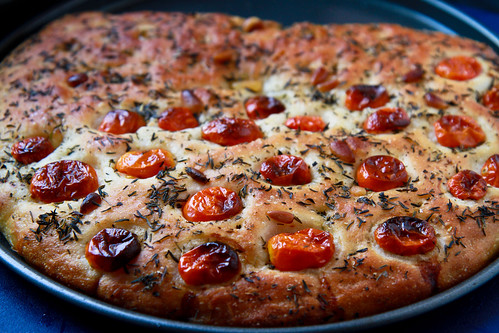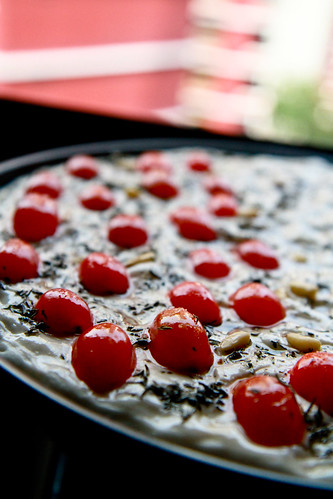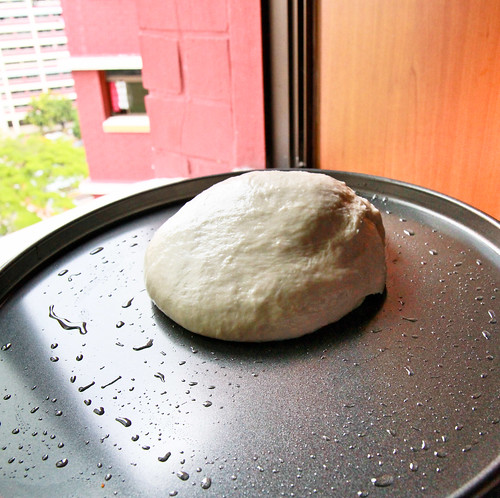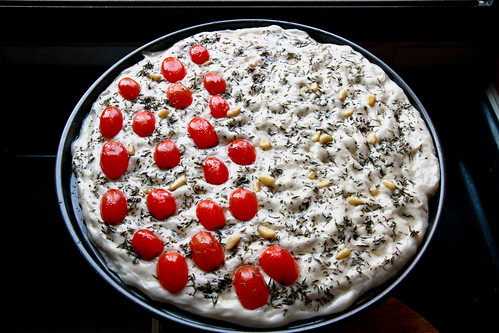As promised, this is the second installment of my focaccia series. This time, I decided to use a recipe from Nancy Harmon Jenkin’s book, Flavors of Puglia. This is a rather old book, dating to 1997, but it is a tome of recipes for anyone wanting to attempt Pugliese recipes (Puglia is at the heel of the boot of Italy, if you get what I mean). Pugliese recipes are very much Mediterranean, considering that it’s so far south of Italy, and it is of no surprise that focaccia is a staple in their cuisine because it is said that focaccia came from the Etruscans, who were greatly influenced by the Greeks. A little bit more about the focaccia – it takes its name from the Roman phrase panis focacius which means a flat loaf of bread cooked under the ashes of a fire or upon a hearth. Of course, most of us bakers don’t have a hearth, so we’ll just have to make do with an oven. Also, if you compare recipes for pizza dough and focaccia, you’ll realize that they are largely similar, if not the same. The focaccia can be regarded as the predecessor of the modern pizza, in more ways than one. It was definitely invented before the pizza (which is essentially flatbread with toppings) and I remember being told that the focaccia will be the first thing into the hearth (in pizzerias or bakeries), to test if the heat of the oven was right for the pizzas. If the focaccia came out right, it was time to load in the pizzas!
I know most Singaporeans think of focaccia as rectangular, but it is made in other shapes – like a circle. I decided to attempt the focaccia pugliese, and since it is traditionally made in a round tray, I decided to follow suit as well. The focaccia pugliese is actually a focaccia di patate, or potato focaccia. It can be topped with slices of potato, but the defining characteristic, in my opinion, is the addition of a mashed potato into the dough. I tried looking up for more information about this focaccia on the Internet but couldn’t find much information about it.
 |
| Yummy round focaccia :] |
Anyway, I didn’t exactly follow Jenkin’s recipe for toppings, because I wanted to use Peter Reinhart’s herb oil as well as incorporate some tomatoes into the focaccia, having ate onion-and-herb versions the past few days. Of course, I couldn’t settle on just one flavor, so it was herbed tomatoes on one side, and pine nuts with herb oil on the other side.
Potato focaccia
Ingredients
For the dough:
1 large potato, about 150g
½ tsp dried yeast
1 tsp salt
60 ml warm water
1 tbl extra virgin olive oil
180 g bread flour
For the herb oil:
½ cup olive oil
1 tbl garlic powder (or fresh chopped garlic is fine)
½ tbl sea salt
1 tsp paprika powder
½ tsp ground black pepper
5 tbls of your desired herb mix. I used:
1 tbl dried basil
1 tbl dried parsley
1 tbl dried oregano
1 tbl dried thyme
1 tbl dried rosemary
Method:
- Preparing the mashed potato. Peel the potato and place it in a large bowl with boiling water to cover it. Place the bowl in a microwave and put it on high for 3 minutes. This will soften the potato enough for it to be mashed. Do note that there will be splashing, so use a microwave cover if you have it. Drain the water from the potato and mash it with a fork/potato masher. Allow it to cool and set aside.
- Preparing the starter. Add the yeast into the warm water. Add 80g of the bread flour into the mixture and let it sit for 30 minutes.
- Making the dough. The mixture should have increased in size and be bubbling a little. Add in the remaining flour. Once incorporated, add in the mashed potato and salt. Add in the olive oil and mix everything well. Once everything comes together in a shaggy dough, you can either use your mixer to knead the dough for about 5-7 minutes or turn it out onto your counter and knead it manually for about 10 minutes, or until the windowpane test is achieved. This dough will be slightly wet because it is a high-hydration dough, so do be sure to flour the counter and oil your hands to ensure that the proportions remain roughly the same. Form the dough into a tight ball and let it rest in a well-oiled bowl for an hour, or until doubled.
- Preparing the herb oil. Warm the olive oil a little, to about 50 degrees, before adding in all the herbs and dried ingredients. Take it off heat and let it stand for 30 minutes before using.
- Getting ready for the second proof. Use your palm to gently press on the dough to deflate it. Press until the whole pan is covered. It does not matter if the pan is not completely covered because the dough will expand for a second time. Using your fingers, make slight indentations all over the dough. This will result in ‘dimples’ in the dough. Add the tomatoes cut-side down onto the dough, pressing it into the dough so that it adheres. Add the raw pine nuts as well. Next, add the herb oil onto the dough, making sure the surface is well covered. Let the dough rest for another 40 minutes, or until it increases to about 1.5 times its size.
- Baking the focaccia. Preheat the oven to 220 degree Celsius and bake for 15-20 minutes. The surface should turn golden brown. Let it cool before removing.
Janine's jots:
- Taste: I didn't like the taste of the focaccia as much as I liked the others, mainly because I found the potato taste a little disconcerting in a bread. The potato taste is not overwhelming, but it is present if you're a discerning eater.
- Texture: The crumb of the focaccia was tight, with the requisite holes and airiness. I found it less chewy than the normal focaccia.
- Storage: Because of the use of tomatoes in the focaccia, you have to store it in the fridge after the first day, otherwise the moisture in the tomatoes will attract mould. It tastes just as good after three days.
- Would I make this again? Having tried other focaccia recipes, this will not be my to-go-to focaccia recipe. However, if you're in search of a focaccia which has a more tender crumb, this will be it.
- Other comments: The herb oil was highly raved about on several websites and forums, but I didn't find it overly impressive. The sharpness of the paprika and black pepper overwhelmed the herbs a little.
In pictures:
 |
| Mash up your boiled potato. You can use any time of potato, but a Russet would be most mashable. |
 |
| This is step 3 where starter is added into the flour, together with the other ingredients before kneading. |
 |
| Oops sorry I was hungry so I ate a bit of the focaccia before I could muster the energy to take photos ;) The baked focaccia will shrink from the pan a little - that's normal! |
Am submitting this to Yeastspotting here :]






3 comments:
OMG! This sure look great for quick lunch or breakfast. Thanks for sharing.
Thanks for sharing this recipe. I tried and it's good.
@fong: thanks for trying the recipe out :)
Post a Comment